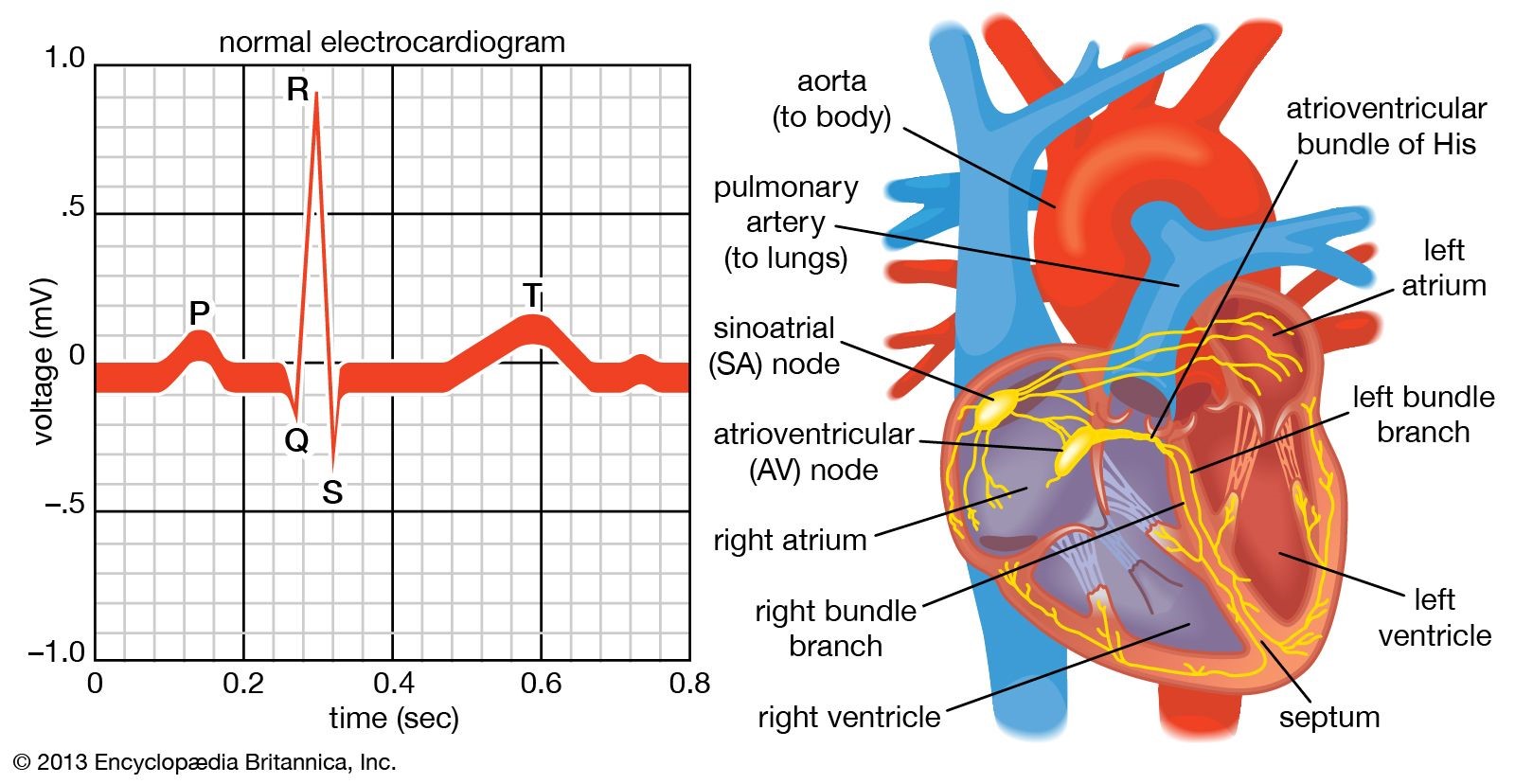A client converts from normal sinus rhythm at 80 bpm to atrial fibrillation with a ventricular response at 165 bpm.
Blood pressure is 162/74 mm Hg. Respiratory rate is 20 breaths per minute with normal chest expansion and clear lungs bilaterally.
IV heparin and Diltiazem are given.
What is the main goal of treatment?
Maintain anticoagulation
Improve oxygenation
Control ventricular heart rate
Decrease SA node conduction
The Correct Answer is C
Choice A rationale:
While maintaining anticoagulation is important in atrial fibrillation to prevent blood clots, it is not the main goal of treatment in this specific scenario.
The client's blood pressure is elevated, suggesting that the rapid heart rate is the more immediate concern.
Additionally, the prompt indicates that heparin has already been administered, addressing the anticoagulation need.
Choice B rationale:
The client's respiratory rate and lung sounds are normal, indicating that oxygenation is not a primary concern at this time.
The fast heart rate is the more pressing issue, as it can lead to decreased cardiac output and potential complications.
Choice C rationale:
Controlling the ventricular heart rate is the main goal of treatment in this case.
Atrial fibrillation with a rapid ventricular response can lead to several detrimental consequences, including:
Decreased cardiac output due to shortened ventricular filling time
Increased myocardial oxygen demand, potentially causing angina or heart failure
Increased risk of stroke or other thromboembolic events
Diltiazem, a calcium channel blocker, is a medication commonly used to slow the heart rate in atrial fibrillation.
By slowing the conduction of electrical impulses through the atrioventricular (AV) node, it effectively reduces the number of impulses that reach the ventricles, thereby controlling the ventricular response.

Choice D rationale:
Decreasing SA node conduction is not a primary goal in this situation.
The SA node is responsible for initiating the normal electrical impulses that trigger heart contractions.
In atrial fibrillation, the electrical activity is chaotic and originates from multiple foci within the atria, rather than the SA node.
Therefore, targeting the SA node would not effectively address the underlying rhythm disturbance.
Nursing Test Bank
Naxlex Comprehensive Predictor Exams
Related Questions
Correct Answer is E
Explanation
Choice A rationale:
While aspirin can help improve heart function in certain cases, such as by reducing inflammation, it's not accurate to say it directly restores normal heart function. This statement oversimplifies aspirin's mechanism of action and could mislead the client.
It's essential to emphasize aspirin's role in preventing clots, which is the primary reason for its use in coronary artery disease.
Choice B rationale:
Aspirin does not affect the oxygen-carrying capacity of blood. This function is primarily carried out by hemoglobin in red blood cells.
Stating that aspirin increases oxygen-carrying capacity could create misunderstandings about its role in coronary artery disease.
Choice C rationale:
Aspirin does not directly make blood penetrate the heart more freely. Its action primarily involves preventing blood clots from forming within blood vessels.
This statement could lead to a misconception about aspirin's mechanism of action, potentially affecting adherence to treatment.
Choice D rationale:
This is the most accurate and comprehensive response. It directly addresses the client's question and highlights the primary reason for daily aspirin use in coronary artery disease.
Aspirin inhibits platelet aggregation, reducing the risk of blood clots that can obstruct coronary arteries and trigger heart attacks or chest pain.
By preventing these blockages, aspirin can help prevent future cardiovascular events and improve the client's overall health outcomes.
Correct Answer is ["C","D"]
Explanation
Choice A rationale:
The ST segment represents the period of time between ventricular depolarization and repolarization. Its elevation or depression can indicate myocardial ischemia or injury, but it's not directly related to normal sinus rhythm determination.
The PR interval, on the other hand, measures the time it takes for the electrical impulse to travel from the atria to the ventricles. While a normal PR interval is essential for normal sinus rhythm, its height relative to the ST segment is not a determining factor.
Choice B rationale:
The number of complexes in a 6-second strip can provide a quick estimate of heart rate, but it's not a definitive criterion for normal sinus rhythm. A normal heart rate in adults typically ranges from 60 to 100 beats per minute, which could correspond to 5-10 complexes in a 6-second strip. However, other factors, such as rhythm regularity and P wave morphology, must also be considered. Choice C rationale:
RR intervals that are relatively consistent are a hallmark of normal sinus rhythm. This indicates that the heart is beating at a regular pace, with equal time intervals between each QRS complex. In contrast, irregular RR intervals suggest dysrhythmia, such as atrial fibrillation or premature ventricular contractions.
Choice D rationale:
One P wave preceding each QRS complex is another essential feature of normal sinus rhythm. The P wave represents atrial depolarization, and its consistent presence before each QRS complex (which represents ventricular depolarization) indicates that the electrical impulse is originating in the sinoatrial (SA) node, the heart's natural pacemaker, and is propagating through the atria and ventricles in a coordinated manner.
Whether you are a student looking to ace your exams or a practicing nurse seeking to enhance your expertise , our nursing education contents will empower you with the confidence and competence to make a difference in the lives of patients and become a respected leader in the healthcare field.
Visit Naxlex, invest in your future and unlock endless possibilities with our unparalleled nursing education contents today
Report Wrong Answer on the Current Question
Do you disagree with the answer? If yes, what is your expected answer? Explain.
Kindly be descriptive with the issue you are facing.
